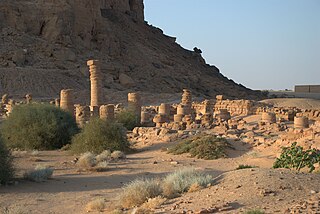- See Al-Maris (suburb) for the suburb of the same name.
Al-Maris (Arabic : المريس) was a Medieval Arabic name for Lower Nubia, the region of the Nile around the first and second cataracts, including Aswan. Because most of the sources for Nubian history during the period are in Arabic, it is sometimes used interchangeably with the Nubian region of Nobadia. The northern section of al-Maris was part of Fatimid Upper Egypt and was semi-independent under the Kanz ad-Dawla between 1046 and 1077 AD. The Kanz ad-Dawla Nasir invaded Nubia in 1066 but was repulsed and his territory raided.

Arabical-ʻarabiyyah[alʕaraˈbijːa](
Lower Nubia is the northernmost part of Nubia, downstream on the Nile from Upper Nubia. Sometimes, it overlapped Upper Egypt stretching to the First and Second Cataracts, so roughly until Aswan. A great deal of Upper Egypt and northern Lower Nubia were flooded with the construction of the Aswan High Dam and the creation of Lake Nasser. However the intensive archaeological work conducted prior to the flooding means that the history of the area is much better known than that of Upper Nubia. Its history is also known from its long relations with Egypt.

The Nile is a major north-flowing river in northeastern Africa, and is the longest river in the world, though some sources cite the Amazon River as the longest. The Nile, which is about 6,650 km (4,130 mi) long, is an "international" river as its drainage basin covers eleven countries, namely, Tanzania, Uganda, Rwanda, Burundi, the Democratic Republic of the Congo, Kenya, Ethiopia, Eritrea, South Sudan, Republic of the Sudan and Egypt. In particular, the Nile is the primary water source of Egypt and Sudan.
The main towns were Aswan (Greek Syene) in Egypt and Faras (Coptic Bakharas, Greek Pakhoras, Arabic Bajrash) and Fort Ibrim (Coptic Phrim, Greek Primis) in Nobadia.

Aswan is a city in the south of Egypt, and is the capital of the Aswan Governorate.

Greece, officially the Hellenic Republic, historically also known as Hellas, is a country located in Southern and Southeast Europe, with a population of approximately 11 million as of 2016. Athens is the nation's capital and largest city, followed by Thessaloniki.

Faras was a major city in Lower Nubia. The site of the city, on the border between modern Egypt and Sudan at Wadi Halfa Salient, was flooded by Lake Nasser in the 1960s and is now permanently underwater. Before this flooding, extensive archeological work was conducted by a Polish archeological team led by professor Kazimierz Michałowski.
The area was occupied by Saladin's brother, al-Malik al-Mu'azzam Shams ad-Dawla Turanshah (Turan-Shah) from 1172 to 1174, but the Ayyubids withdrew a few years later. Some parts were overrun by the Banu Kanz and others were held by the Christian kings at Dotawo. It was nominally annexed to Mamluk Egypt by Baybars in 1276, but continued to be at least partially ruled by autonomous Christian kings at Dotawo until its conquest by Sennar in 1504.

An-Nasir Salah ad-Din Yusuf ibn Ayyub, known as Salah ad-Din or Saladin, was the first sultan of Egypt and Syria and the founder of the Ayyubid dynasty. A Sunni Muslim of Kurdish ethnicity, Saladin led the Muslim military campaign against the Crusader states in the Levant. At the height of his power, his sultanate included Egypt, Syria, Upper Mesopotamia, the Hejaz, Yemen and other parts of North Africa.
Shams ad-Din Turanshah ibn Ayyub al-Malik al-Mu'azzam Shams ad-Dawla Fakhr ad-Din known simply as Turanshah was the Ayyubid emir (prince) of Yemen (1174–1176), Damascus (1176–1179), Baalbek (1178–1179) and finally Alexandria where he died in 1180. He is noted for strengthening the position of his younger brother, Sultan Saladin, in Egypt and playing the leading role in the Ayyubid conquests of both Nubia and Yemen.
Banu al-Kanz was a semi-nomadic Muslim dynasty of mixed Arab-Beja ancestry that ruled the border region between Upper Egypt and Nubia between the 10th and 15th centuries. They were descended from the sons of sheikhs of the Arab Banu Rabi'ah tribe and princesses of the Beja Hadariba tribe. They gained official control over the region of Aswan, Wadi Allaqi and the frontier zone in the early 11th century when their chief, Abu al-Makarim Hibatallah, captured a major rebel on behalf of the Fatimid authorities. Abu al-Makarim was accorded the title Kanz al-Dawla by Caliph al-Hakim and his successors inherited the title. The Banu Kanz entered into conflict with the Ayyubids in 1174, during which they were defeated and forced to migrate southward into northern Nubia, where they helped accelerate the expansion of Islam in the mostly Christian region. They eventually assumed control of the Nubian Kingdom of Makuria in the early 14th century, but by the early the 15th century, they were supplanted by the Hawwara tribesmen dispatched by the Mamluks to combat the Banu Kanz. Their modern-day descendants are a Sudanese tribe known as the "Kunuz", who live in the far north of the country.










